By G. L. Pease
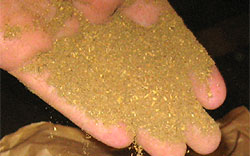 It’s happened to most of us at least once, and if it hasn’t, it will. We dive into our collection for some tobacco we’re looking forward to smoking, open the container, whether tin, jar or plastic pouch, and find that the contents have been entombed just long enough and at just the right conditions to have been rendered as dry as mummy dust, and just about as appealing. As we fight back our dismay, and attempt to delicately extract the contents, hoping to somehow rescue a decent smoke from the rubble of our disappointment, the desiccated stuff just crumbles between our careful fingers, and we’re left with powder where we wanted ribbons.
It’s happened to most of us at least once, and if it hasn’t, it will. We dive into our collection for some tobacco we’re looking forward to smoking, open the container, whether tin, jar or plastic pouch, and find that the contents have been entombed just long enough and at just the right conditions to have been rendered as dry as mummy dust, and just about as appealing. As we fight back our dismay, and attempt to delicately extract the contents, hoping to somehow rescue a decent smoke from the rubble of our disappointment, the desiccated stuff just crumbles between our careful fingers, and we’re left with powder where we wanted ribbons.
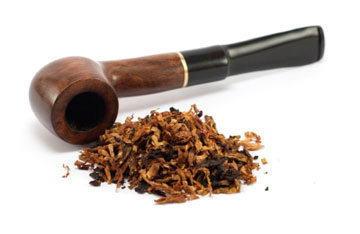 Moisture content is one of the things that can make or break a great tobacco. If the tobacco is too dry it can make evenly filling the bowl difficult. The strands will break apart and turn to dust as we’re handling it, potentially clogging the airway, and what we do manage to get into the bowl with some semblance of structural integrity is guaranteed to burn quickly, offering an often harsh smoke, lacking the true flavors we expect. Too moist, on the other hand, and we can be tempted to over-pack the bowl, resulting in a steamy, hot, muted smoke, and a damp, gooey mess in the heel of the pipe, providing we manage to get the stuff lit.
Moisture content is one of the things that can make or break a great tobacco. If the tobacco is too dry it can make evenly filling the bowl difficult. The strands will break apart and turn to dust as we’re handling it, potentially clogging the airway, and what we do manage to get into the bowl with some semblance of structural integrity is guaranteed to burn quickly, offering an often harsh smoke, lacking the true flavors we expect. Too moist, on the other hand, and we can be tempted to over-pack the bowl, resulting in a steamy, hot, muted smoke, and a damp, gooey mess in the heel of the pipe, providing we manage to get the stuff lit.
Different smokers have their own preference for the moisture content of their tobaccos, but, each blend will have a fairly narrow range of moisture content that is optimal for squeezing out of it maximum enjoyment. What’s acceptable for blended, ready to smoke tobaccos, and how can we can get a feel for what’s right – what works for us, and what works against us? And, how can we adjust it, when necessary, to maximize our enjoyment?
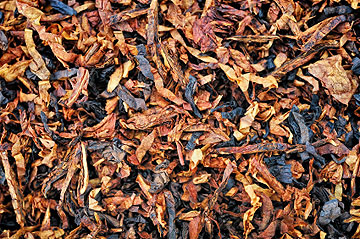 Moisture content (moisture by weight, or MBW) is measured as the weight of the water present in the leaf, expressed as a percentage. In the range of 8-10%, tobaccos will be very dry and frangible. The strands crumble without much prodding, and cannot stand up to any sort of rough handling. If packaged this dry, the leaf will suffer during handling and shipping, and the consumer is likely to find a lot of dust at the bottom of their tins or pouches.
Moisture content (moisture by weight, or MBW) is measured as the weight of the water present in the leaf, expressed as a percentage. In the range of 8-10%, tobaccos will be very dry and frangible. The strands crumble without much prodding, and cannot stand up to any sort of rough handling. If packaged this dry, the leaf will suffer during handling and shipping, and the consumer is likely to find a lot of dust at the bottom of their tins or pouches.
Some smokers enjoy their mixtures in this range, however, and dry tobacco can have some advantages. If handled gently, the pipe carefully and not too-tightly packed, it will certainly light easily, and burn without much attention. This can result in a fairy effortless smoke, and in the case of oriental and Latakia blends, it can even be a pleasant one, if perhaps a bit flat. But, if there’s much Virginia in the mix, there’s got to be more moisture before it will offer up its wonderful, subtle sweetness. In general, Virginias are less amenable to being smoked when too dry. Burleys, too, will be harsher and more acrid when dry, presenting more of what is sometimes referred to as the "Burley Curse."
Once tobaccos reach 12-14% MBW, the strands becomes less fragile. The individual ribbons or flakes will remain pliable, are easier to pack evenly, burn with slightly less vigor, and deliver more of the tobacco’s subtle flavors. This is the range at which I prefer for most of the blends I enjoy. Unfortunately, it’s not quite ideal for manufacturing and packaging. While at this moisture level, the leaf is reasonably robust, and will withstand somewhat rougher handling (blending, packaging and shipping) without sustaining too much damage, it’s not ideal for those of us who like to age our tobaccos for months, years or even decades. The tobacco will certainly mellow over time, but without a little more moisture, some of the wonderful fermentation processes that we expect will be either dramatically slowed, or may not even happen at all.
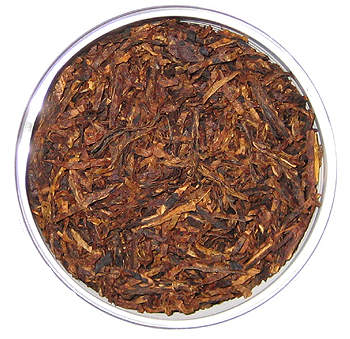 The region of about 15-18% MBW is a great target for manufacturing, packaging, shipping and aging. [1] The downside is that the tobacco may have to be dried slightly before it will deliver the best smoke; in this range, more water vapor is produced during smoking, slightly diluting the flavors and producing a "gassy" smoke.
The region of about 15-18% MBW is a great target for manufacturing, packaging, shipping and aging. [1] The downside is that the tobacco may have to be dried slightly before it will deliver the best smoke; in this range, more water vapor is produced during smoking, slightly diluting the flavors and producing a "gassy" smoke.
Perhaps more importantly, this water vapor carries more heat than the smoke particles themselves. More heat leads to hotter smoke, and a greater tendency towards the dreaded "tongue bite." (Even though bite is a chemical response to irritants, the additional heat increases reaction rates, and no good can come of that. Moister tobaccos can also be harder to keep lit, which often results in more furious puffing, compounding the problems.) Fortunately, assuming limited use of humectants like Propylene Glycol (PG), it’s easy to dry a tobacco that’s too moist, and this happens relatively quickly under all but the most humid conditions. An entire tin’s contents, or just enough for a bowl or two can be easily dried down.
Go above 18% MBW, and things start to get downright sticky, though some aromatics are sold at moisture contents even in excess of 24%. If not for the preservatives used on these, mold would be a significant problem, especially in warmer climates.
Though quantitative testing [2] is probably not interesting to most smokers, it’s pretty easy to get an intuitive fix on these ranges, and quickly calibrate our fingers to feel what works best for us and what doesn’t. Tobacco that’s too dry is pretty obvious. It’ll disintegrate with the slightest provocation. If it’s too moist, it can be pressed into a ball, and will remain in that state. At optimal smoking moisture, strands should be able to withstand handling without breaking up easily. The tobacco will feel lively, and if bunched together, squeezed into a ball, will spring back with some exuberance. It’ll fluff up a little during the initial light, but still char easily. Here’s where the best smoking occurs, at least in most cases.
Experiment a little with your favorite blends. Learn to feel what’s right for you, and pay attention to how different tobaccos and different pipes respond to tobaccos at various moisture levels. Drying tobacco is easy enough. Spread it out on a sheet of paper, and let nature take its course. Unless the tobacco is very wet, or the atmosphere very humid [3], it will only take a few minutes for things to reach the right level.
Raising the moisture, on the other hand, can be a little trickier.
There are some who believe that, since tobaccos are repeatedly moistened and dried during processing, that blended leaf can undergo the same treatment without any ill-effects. It ain’t so. Once the tobaccos are blended, conditioned, and put into tins, they begin a wondrous dance, with bacteria and yeasts and organic chemical reactions taking place that are responsible for the phenomena we know, collectively, as aging. Some of these reactions are very sensitive, and if the environment within the tin is suddenly changed, all bets are off.
Rehydrated tobaccos can still be very good, even excellent, but they probably won’t be the best they could be. Still, it’s always worth a try. It’s essential, however, to proceed with some care. The leaf takes time to absorb moisture, and the amount of water we need to add is typically very small. If we have 50g of tobacco with a moisture content of 10%, and we want it to be 12%, we need to add 1ml of water evenly throughout the tobacco. Not an easy hat trick.
But, here’s a very simple and controllable method, requiring no specialized equipment. Put the tobacco in a bowl large enough to hold while leaving a significant head-space. If you think the bowl is too large, it’s probably just about right. Cover the top of the bowl with a damp towel (if your tap water has strong smells, it’s best to use filtered or distilled water), held in place with a plate. Ensure that the towel is well away from the tobacco. This creates a humid environment from which the tobacco will gradually take up moisture as it equilibrates. It can take a day or even longer before the tobacco reaches the desired moisture. Check it every few hours, more frequently if it’s hot, give the tobacco a little gentle stir, and replace the towel and plate until the moisture has reached the desired level. If you go a little too far, just dry it back down. I’ve done this with great success with some vintage blends that had gotten too dry, and it works wonderfully.
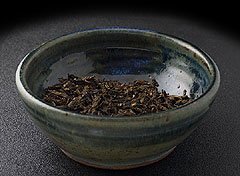 |
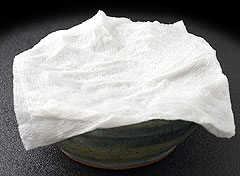 |
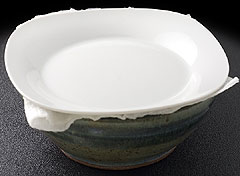 |
NOTES:
1. The difference between tobacco that’s dry and tobacco that’s too moist is only a few percentage points, and properly moistened tobacco is good insurance against losing 10-20% as dust if the blend is too dry. To my mind, 2-3 additional grams of water in 100g of tobacco is a small price to pay for that assurance.
2. If you have access to an accurate digital scale, and an electric oven (gas ovens burn with too much moisture), you can destructively get a fairly accurate measure of the moisture content of a blend. Precisely weigh a sample (of at least 1000 times the resolution of your scale) into a dish, and place this in the oven at about 180˚F (80˚C) for an hour or so, with the oven’s door slightly ajar. When the tobacco has dried completely, re-weigh it immediately. The moisture content can be calculated from the difference:
100 * (weight before – weight after)/weight before
3. Some years ago, I did a little research to discover where an average tobacco will equilibrate at various relative humidity (RH) levels. This was prompted by some questions as to whether or not pipe tobacco could be stored in a cigar humidor. This isn’t a good idea for a couple of reasons. Tobaccos quickly take on flavors and aromas from their environment, and we don’t want our cigars tasting like pipe blends, or vice versa. And, it turns out that while cigars are happiest in the region of 65-70% RH, a somewhat lower range is more suitable for pipe tobaccos. At an RH of 60%, pipe tobaccos will tend to stabilize near 12% MBW, and by 66% RH, it will find itself approaching 14% MBW. At 70% RH, the tobaccos will go beyond 16% MBW, which, as discussed, is too high for proper smoking. Keep them separate. They’ll both be happier, and so will you.
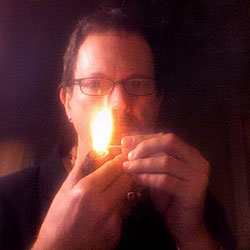
Since 1999, Gregory L. Pease has been the principal alchemist behind the blends of G.L. Pease Artisanal Tobaccos. He’s been a passionate pipeman since his university days, having cut his pipe teeth at the now extinct Drucquer & Sons Tobacconist in Berkeley, California. Greg is also author of The Briar & Leaf Chronicles, a photographer, recovering computer scientist, sometimes chef, and creator of The Epicure’s Asylum. |















Excellent article Greg! This addresses a gap in information
that so many of us have struggled with…, by trial and error.
Thanks!
Another Excellent article Greg! Some of us have been dead on where rehydration is concerned. I will abandon my old method in deference to your suggestion.
Thanks again, excellent read!
A good article.
Dunhill used to say Latakia Mixtures should have less moisture than Va Flakes (and consequently you got more tobacco in his tins).
We constantly repeat on SF to dry out Va flakes to get the best smoking but I do agree with Greg that it’s a fine line between dry enough and too dry; for me it’s very much horses for courses and some baccy (SG FVF for instance) needs a lot more air time than other flakes.
It really is worth a bit of experimentation.
Wonderful reference work. The moisture level question arises from time to time in the forums, and it’s great to have an authoritative source to cite right in the featured articles of PipesMagazine. (Another home run Kevin.)
Very good reference article. I’ll try your method Greg. I used to put moistened cotton balls, but your method looks a lot better.
As an aspiring writer myself, I was amused at the author’s attempt at sophisticated verbiage. I felt like a much simpler vocabulary would not only have been more appropriate for your readers, but would have done away with my reading it haltingly, wondering at every amazing word why something more simple wasn’t chosen. Granted, we pipe smokers are an elegant bunch, but hey, come on down where we are!
I live in the semi tropics. All tobacco here needs some drying time.
Looks like just plain English to me. If you really want elegant phraseology, try one of Patrick O’Brian’s Aubrey/Maturin novels. But to me, Mr. Pease’s explanation makes perfect sense as is (or sui generis). Thanks, Greg.
I think this is a great article and I was thrilled to have Greg write it. I often request writing on certain topics, but Greg came up with this one and it was a great idea since it is such an often discussed topic.
@ Jim Sides
If you want simpler verbiage, read the stuff I write. LOL.
I think the audience here is fairly sophisticated and above average in reading ability, and see no reason to insult their intelligence by “writing down” to them; this ain’t Newsweak.
However, perhaps in my next column, I shall avoid engaging with any propensity I might have towards obfuscatory polysyllabification, in hopes of not generating a preponderance of overly sophisticated verbiage, impenetrable compound sentences, or verbs in the subjunctive mood that might be deemed haughty.
In that spirit, here is my revised article:
Some tobacco is too dry, and that’s not a good thing. Some is too moist, and that’s not a good thing, either. If it’s too dry, add a little water. If it’s too wet, let it dry out some. Use a bowl and a wet towel, and, voila! Just like magic.
Hey! That’s almost good enough for Martha Stewart!
-glp
Thanks Greg. That was appreciably improved, immensely facile to read, and most breviloquent for my indubitably assiduous schedule.
Quoth GLP: “Hey! That’s almost good enough for Martha Stewart!”
It’s a good thing!
clovisman scooped me with “It’s a good thing”. 🙂
Excellent article Mr. Pease. I’ve tried various methods to bring tobaccos back from the dead (re-humidification), but yours makes so much sense, I’ll try it next time. (That can’t be far off here in arid West Texas.)
Jimbo
I prefer my smoking tobacco quite dry, so what I usually do is take out about 20gr from my stock and put it in a little 20gr tin which I can air dry in the morning. My bulk stock I store in airtight containers (all the same size for ease of storage)into which I place my tobacco, about 120gr per container, I place a piece of tin foil on top of the tobacco, on-top of which I place a piece of damp paper towel. This method keeps my bulk stock nice and moist.
Great article Greg. I’m glad you addressed this issue. I have been smoking a pipe for over forty years, and have always believed that pipe tobacco should have a certain amount of moisture content, just like a fine cigar. I just don’t get the same enjoyment out of dry tobacco. However, there are several members of my local pipe club who disagree with me. They believe that pipe tobacco should be as dry as dust, and that dry tobacco burns, and tastes better. They also believe that tobacco can be aged in this condition, so I guess one has to consider the source of such misinformation.
Mr. Pease, I truly like your writing style. Having read all your stuff on your own site, I’m glad to see you here on this one with some fresh articles and musings. I haver told several friends about your site and style of writing. Dude just keep on what you’re doing. If somebody can’t tolerate your style then there are other less distinguished easier to read sites to entertain them.
Your ideas and thoughts on re-animation of tobaccos is right on and empirical.
Many thanks, gentlemen. I’m happy to have landed here.
when i upgraded my cigar humidor i am using the old one for the pipe tobacco.
Works wonders especially in the winter where the heating sucks all the humidity out of the air.